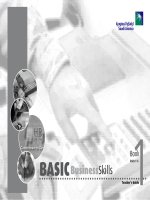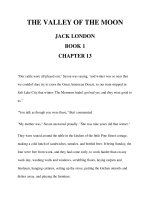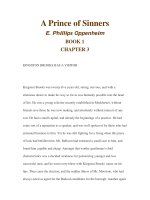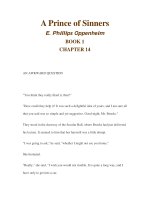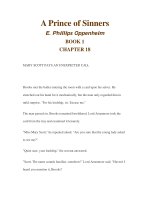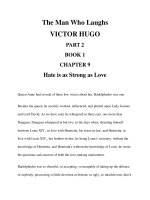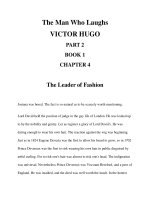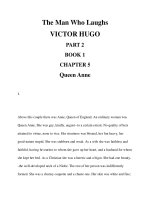welcome 1 teacher book pdf
Bạn đang xem bản rút gọn của tài liệu. Xem và tải ngay bản đầy đủ của tài liệu tại đây (11.71 MB, 119 trang )
TEACHES B OO K
Publishing
Express
Welcome I
lntroductionto the Teocher
Descriptlon- Syllobus- Components
'Jr..-tJ
r
.
'ffelcome is a two-levelcourse at primary level for
:: dren learningEnglishfor the firsttime.lts syllabus
s Dased on graded structures and vocabulary'
Nr'come enablespupilsto use Englisheffectively
tr-,1 gFlsUresthat they have fun while learning.
it?come developsall four skills (reading,writing,
sening and speaking) through a variety of
::n"municative tasks and everyday dialogues. lt
-=;y'clesvocabularyand grammarregularly.
telcome 1 consists of fourteen units. Each unit
:::ntains material for three lessons of about 50
The Class CDs or Cassettes include all the
recordingsfor the listeningactivitiesin the Pupil's
Book and the Workbook. They also include a
recordingof the play so that the pupils are given a
model of the oronunciition and intonationof the
languageused.
The Pupil'sCD or Cassetteincludesall vocabulary,
dialogues,texts,pronunciationtwistersand the play,
all of which are necessaryfor home study. Pupils
have the chance to listen to these recordingsas
many times as they want to improve their
pronunciation
and intonation.
The Multimedia CD Rom includes exercisesfor
pupilsto reinforcetheirlanguageskills.
-rnL.rt€S e€lCh.
1 and
TheAlphabet Booklet accompaniesWelcome
introducesbeginnersto the new lettersand sounds.
C.omponenlsot eoch level
'JrJtU
--e Pupil's Book presents new words, grammar
silJcturesand functionsin a clearway.The language
s sresentedin contextthrough lively dialoguesor
+- oyable texts. A variety of functional exercises,
and games help pupils practisethe new
-ngs
eF€uage in an enjoyable way. Dialogues,texts,
..crrgs,rhymes and other listeningactivitiesare on
:e CD or cassette.
The course presents the adventuresof six children;
Wendy,an 11-year-oldcomputerwhizz;Tom, her clever
brother;Eddy,who is 11yearsold and likesrap
S-year-old
who likes
and basketball;Lin,a well-behaved1O-year-old
ballet; Cindy, a graceful 12-year-old,and Oscar, an
Thesesix children,with Masid,a
intelligent10-year-old.
cheerful but mischievousgenie, and Eric, the naughty
--e Workbook consistsof 14 units of four pages parrot,
are the main charactersin the series.
:aci-r. Each unit is divided into five sections:
Variousothercharactersappearin the unitssuch as, Miss
i3,cabulary,Grammar, Communication,Listening
Parkerthe teacher,the children'sparents,Pinkythe rabbit
:"d Reading & Writing. The Workbook aims to
and the monsterson the planetZiccom.
::rsolidate the language points and grammar
:TJcturesthat appearin the Pupil'sBookwithvarious
: :. .....:.'
:rercises. lt can be used either in class or for
"3.
-'cmework.
Pupil'sBook
to- use the
- "How lirr
rr
L
-re Teacher'sBook givesstep-by-steplessonplans
ard the answersto the exercisesfor both the Pupil's
pages
3ook and the Workbook.lt also containsextraideas Thereare 14 unitsdividedintothreelessonsof two
provides
three
50of
for
a
minimum
work
Each
unit
each.
:n how to present new words and grammar
lessons.
minute
s:ructures,
as well as four photocopiableassessment
::sts in two versionsand tapescriptsof the listening
activities.
-re Picture Flashcards include all the pictures
-ecessaryto presentand revisenew structuresand
"ocabulary.
Welcome I
Note: AfterUnit4 you can ask pupilsconceptquestions
aboutthe dialogueafterpupilshaveactedout the
dialoguein pairs.
Each lesson startswith the presentationof new words for
the unit.Eachword is presentedthrougha pictureso that
pupilsunderstandthe meaning.
A
EX.4
iKao"r*ot"ED pRActcEoF sTRUCTURES:
Each dialogueis followedby a structuralexercisewhich
recyclesvocabularyand grammarstructurespresentedin
the dialogue.
Presentationwith books closed.
a
Pin up relevantflashcardsone at a time.
Presentationwith pupils' books closed.
o
Pointto each and modelthe word/phrase.
o Pin up relevantflashcardsone at a time.
a
Pupilslisten,then repeatchorallyand individually.
o Presentthe structureorally.
a
Point to flashcardsin random order and elicit new
. Writeit on the board.
vocabularyfrom pupils.
Pupils'books open. Play the cassette.Pupils listen o Pupilsrepeatchorallyand individually.
. Repeatwith the rest of the flashcards.
and repeat.
o Wipethe exampleoff the board.
Note:Avoid using pupils'mothertongueto translatenew
o Pointto the flashcardsin randomorder.
words. Use miming,classroomobjectsor picture
o Elicitcorrectanswersfrom pupils.
flashcardsinstead,wheneverthis is possible.
o Pupils'booksopen.
o Readthe example.
Presentation with books open.
o Pupilspractisethe structureof the examplewith all
. Playthe cassette,
pictures.
o Pausebetweeneachword.
o Pupilsrepeatchorallyand individually.
Presentationwith pupils' books open.
o Show pupilsflashcardsin randomorder. Pupilssay
o Readthe example.
the new word/phrase.
o Pupilsrepeatchorallyand individually.
A
o Individualpupilspractisegrammarstructureswith
Exs.2 & 3
PRESENTATT.N:
ffo^rocuE
the rest of the pictures.
Eachdialogueis precededby a listeningactivity.Ex.
o Pupils'booksclosed.
2 is usuallya lead-inquestionor a listeningtask with
o Show pupilsrelevantflashcardsin randomorder.
two possibleanswerswhich pupilshaveto complete o Pupilspractisethe grammarstructures.
before reading the dialogue. This way pupils
familiarisethemselveswith the dialogue (Ex. 3),
A
practisingtheir listeningcomprehensionat the same
GRAMMAR
l
time.
Useful grammar tables present structuresfrom the
o Readand explainthe instructions.
Always present grammar structures on the
dialogue.
o Readthe questionand possibleanswers.
in each lessonplan in the Teacher's
explained
board,
as
o Ask pupils to look at the picturesin Ex. 3 and
practisegrammarstructuresin the exercises
Book.
Pupils
guesswhat the dialogueis about.
that followthe table first orally,then in writingin class.In
. Playthe cassetteonce or twice,while pupils
all writingexercisesencourageaccuracyin punctuation.
completethe task.
o Checkpupils'answers.
\i-7
rLAll dialogues cover areas of interest '--:rL:-
knowredse
of chirdrenand focus
pupils'listeningand readingskills. ""
.
#JJ':#;
Playthe cassettewith pausesbetweeneach
exchange.
o Pupils listen and follow the lines and repeat
chorallyand individually.
o Checkpupils'pronunciationand intonation.
o Pupilsact out the dialoguein pairs.
JL-
)(cor'rmthrcArloN
All useful communacdfue @erns presented in the
dialogue are further ryUeO so thd ptpils may have
more practice and be eb b uce trcrn appropriately.
These pattems are reccded so ffi grpib acquire the
Rlpils memorise
correct pronuncidim ad nrtafin
thesepatterns.
. PlaythecMqeqhedh
pausesbetween
each excfnrge-
Welcome I
Pupilslisten,followthe linesand repeatchorallyand
individually.
Pupilsread and act out the dialoguein pairs.
*
TRANSFER
Eachlessonendswith a free-practice
exercise.Pupilsuse
the structurespresentedbeforeto act out dialogues,or
make sentencesorally about themselves.After pupils
havedone the exerciseorally,they do it in writingin class.
This lesson revises the vocabularyand the grammar
structures that have been presented in the first two
lessonsof eachunit.lt is laidout differentlyto the previous
lessons. The lesson starts with a text-based exercise
followed by various tasks such as comprehension
questions,listeningor matchingactivities.
The project work in lesson 3 providesessentialwriting
practicefor the students.Here,they get the chanceto use
the structuresand the vocabularythey havelearnedfrom
the whole unit.The lessonends on a fun note by playing
gamesand singinglivelysongsadaptedto the needsand
the knowledgeof the pupils.
Games
In this sectionpupils practisestructurespresentedin
lessons1 and 2 in livelyand competitiveactivities.The
games,for individualsor pairs,are shown clearlywith
examples so that pupils will have no difficulty in
understandinghow to play.Clearinstructionsfor each
game are given in the lesson plans in the Teacher's
Book. Always explain the game to pupils before
playing.
Songs
Eachunit ends with a song aimingto practisepatterns
and vocabularytaughtwithinthe unit.
o Playthe cassette.
o Pupilslistenand followthe words.
. Readthe song and explainany unknownwords.
o Pupilsrepeatchorallyand individually.
. Playthe cassetteagain.
o Pupils listenand sing along with the recording,
followingthe words.
Units ond Tests
Therearefour revisionsectionsin the Pupil'sBookset out
in the followingway:
- Text-based exercise
Revision1: Units1, 2 and3
Pupils listen to and read a text adapted to match
pupils'needsand ability.The text is also recordedso
Revision2: Units4, 5 and 6
that pupilscan practiselisteningas well as reading.
Revision
3: Units7,8,9 and 10
Revision
4: Units'11,12,13and 14
- Exercises
TheTeacher'sBook providesclearinstructionson how The revisionsectionsserveas preparationin classfor the
correspondingtests in the Teacher's Book. Pupils
each exercisein Lesson3 should be taught.
familiarisethemselveswith the layoutand contentof the
- Proiect
tests which are divided into four sections:Vocabulary,
The text itselfservesas a modelfor pupilsto produce Grammar,Communication,
Reading& Writing.
a short piece of writing,as describedin the Project There are four photocopiableassessmenttests, in two
exercise.Pupils do the exerciseorally, then are versionseach,at the back of the Teacher'sBookfollowed
assignedit as writtenhomework.All projectswork with by markingschemes.
the Photo File sectionat the end of the Pupil'sBook.
Pupils write their text in the space provided in the
Photo File section,attach or draw pictures,then cut
out the page and hand it in to be corrected.Pinningup
pupils' projectwork in the class will make them feel
proud of what they haveachievedso far.
There is an extra unit at the end of the book containing
- Twister
Christmasactivities.This unit is to be coveredas a leadfhis is a regularexerciseon soundsin English.Play up to Christmas.
the cassettefocusing pupils' attentionon the sound
presentedeachtime,then pupilspractisechorallyand
individually.
Welcome I
- How to check new words/structures:
Pin up relevantflashcards.Point to each and elicit
answersfrom pupils.
Also includedat the end of the Pupil'sBookis a shortplay.
This providespupilswiththe opportunityto bringto lifethe
charactersin Welcome7, by taking on roles and acting
out a shortstorywhich also recycleslanguageand songs
already taught. In the Teacher'sBook there are stage
directionsfor those teacherswho wish to put on an endof-year performance.The dialogue is also on CD or
cassette,giving the pupils a model to emulate. Hand
puppetsat the back of the Workbookcan be cut out and
used whilepupilspractisethe play in class.
- How to check copying:
Collect pupils' notebooksand correct their copying,
puting emphasis on the importance of clear
handwriting.
- How to check dictation:
o Dictatevariouswords/phrases.
Pupilswritethem in
their notebooks.
o Show pupilsrelevantflashcards.Pupilswritedown
the relevantword.
Correctpupils'dictation.lf pupils have made spelling
mistakeswrite down these words and ask pupils to
writethem againtwo or threetimes.Encouragepupils
by praisingtheireffortsand/orputtingstickerson their
dictation papers. Stickers are provided in the
Workbook.
AftercompletingLessons1,2 and 3 of each unit,pupils
turn to the Workbook for Lesson 4. The Workbook
contains extensionactivitiesrelatingto the units in the - How to check role play:
Pupil'sBook. Each unit in the Workbookis dividedinto
Pupils act out the relevantexchangesin pairs. lt is
Vocabulary, Grammar, Communication, Listening,
advisableto use flashcardswhereverpossible.Check
Reading& Writing.Someof the exercisescan be covered
pupils'intonationand pronunciation.
in class and others may be assigned as written
homework.The Workbookcontainscolourfulillustrations,
hand puppets and stickers, providing the pupils with
additionaltools to completethe elftraactivities.
qssign ond check pupils'
homework
At the end of each lesson plan there is a suggested
homework assignment. Always write the assigned
homeworkon the board so that pupilscan copy it in their
notebooks.Ask pupilsto usethe Pupil'sCD or Cassetteto
practise further and improve their pronunciationand
intonation.
of a
Homeworkis alwayscheckedbeforethe presentation
new lesson.
Welcome I
Contents
A.
c.
D.
B.
My Alphobet Book
1 apple
2 ball
A
1b
2c
3g
4m
B 1 B, D, E, H, J, K, M, O, Q, T, U, W,Y, Z
2 c,e, f, i, j, l, n, o, q,t, u, w, y
4
lemon, hat, glass,ice cream,jam, kite
1 man
2 orange
c
e,i,o,u
D
b, c, d, f, s, g, m, l, k, h, n, r, e, t, v, x,w,z,y
E
ship,cheese,phone,shell,thumb
F
1 man
2 table
3 box
4 glass
5 zebra
6 lemon
7 cheese
I phone
G man, hat, lemon,kite,jam, ice cream
3 queen
4 pen
I
1 vase
2 woman
3 yellow
4 umbrella
5 frog
6 kite
7 table
8 orange
BALL, GI.ASS, VASE, YELLOW,WOMAN, MAN,
SHELL,FROG,TABLE,ZEBRA
4
1 zebra
2 vase
3 yellow
4 box
5 woman
6 star
7 umbrella
8 table
1
2
3
4
umbrella
lemon
ring
yellow
5
6
7
8
apple
frog
star
orange
I egg
10 jam
11 glass
Unirl-He llo!
( pp. 4
9)
Read names 1 - 4 and explainthe instructionsto pupib.
Playthe cassette.Pupib tick the namesthey hear.
What'syourname?,My nameis, I'm,Howare
you?,I'm fine thanks,How do you spellthat?
Who'sthat?
Namesto be ticked:
2 Eddy
3 Lin
4 Oscar
3. Now, listen ogain and read.
Goodmorning,Hello,Goodbye,Goodafternoon,
Goodevening,Goodnight,school,friend,
teacher,parrot,Who'sthat?
Playthe cassette.Pupilslistenand follow the lines.Play
the cassette again with pauses for pupils to repeat
chorallyor individually.
and
Checkpupils'pronunciation
intonation.Pupilsread out the dialoguesin pairs.
introducingoneselfand others, greetings,
people,spellingone'sname
identifying
Lookand sag.
introducingyourself, friend/peVteacher
tr
tr
tr
Vocabulary:Good morning,Goodbye,Good
afternoon,Good evening,Hello,Good night,Hi
Languagefocus: How are you? - I'm fine,
thanks- What'syour name?- Hello!- Oh, hi!
-Goodbye(Bye)
Grammar: I am (l'm) - What is (What's)- My
nameis (My name's)
TION
A
z - ro
)KrrasxcARDs
Pupils'books closed.Show pupilsflashcardNo. 7. Say
"Good morning". Pupils repeat chorally and individually.
Pin up the flashcardon the board. Show pupilsflashcard
No. 8. Pupils say "Good afternoon" chorally and
individually.
Do the samefor flashcards9 and 10. Pupils'
books open. Pupils look at Ei. 4. Read out the example.
Pupilsdo the exercise.
2 Good afternoon!
3 Good evening!
4 Good night!
GRAMMAR
Ask pupils to take a rectangularpiece of paper, fold it
longwaysdown the centre,writetheir nameon it and put
it in front of them.
1. Listenand repeat.
A
ffir^srcARDsr - 6
Pupils'books closed.Pin up flashcards1 - 6. Pointto
each one and say the appropriateword/phrase.Pupils
repeat chorally and individually.Explain how each
greetingis used:
Goodmorningis saidfrom momingto noon (12.00pm)
Good afternoonis said from 12.00till 5.00 pm.
Good eveningis said from 5.00 till midnight.
Good night is said when you are leaving or going to
bed.
Diaw pupib' attentionto the clock faces in the flashcards.
Pupils open their books. Play the cassettefor Ex. 1.
Pupilslistenand repeatchorallyand/orindividually.
Writeon the board and read aloud:
Whatis your name? - My name is Oscar.
Pupilsrepeatchorallyand individually.
Writeon the board and read aloud:
What'syour name? - My name'sOscar.
Pupilsrepeatchorallyand individually.
Writeon the board and read aloud:
lam Eddy. - l'm Eddy.
Pupilsrepeatchorallyand individually.
Teachthe long and shortforms of I am - I'm. Show on
the board how the apostrophereplaceslettersin short
forms:
lhm-l'm
lam
What is - Whatts - What's
My name'*s- MYname's
My name is -t
tr
tr
Vocabulary: friend, school, teacher, parrot,
Who's that?,welcome,spell,everyone
language focus: Who's thaP That's ... - Hello,
everyone- This is ...... - How do you spell it?
Explainthat in questionswe use a questionmark (?).
What'syour name?
Say to a pupil: Hello, l'm
Repeat with some
Pupif answers:My name's
more pupils. Choose a pupil to take the part of the
"teacher"askinganotherpupil "What'syour name?"
Check pupils' HW.
5. Reodand wrlte.
Ask pupils to look at the dialogue between Eddy and
Oscarand fill in the missingwords orally,then in writing.
Pupilsread the dialoguealoud in pairs.
Eddy: Hello,I'm Eddy.What's your name?
Oscar: My name's Oscar.How are You?
Eddy: I'm fine,thanks.
Extension:Pupilsact out similardialoguesin pairs.
6. Look,read,and,choose.
1. Llstenand.repeat.
II - 15
F]ASHCARDS
Pupils'booksclosed.Pin up flashcards11 - 15. Pointto
each one and say one appropriateword/phrase.Pupils
repeatchorallyand individually.Pupils'booksopen. Play
the cassette. Pupils listen and repeat chorally and
individually.
Explainto pupilsthat they must choosethe correct
orally,then
in items1-3.Pupilsdo theexercise
sentence
in writing.Askpupilsto justifytheiranswers.
la
2b
3a
7. Llstenand repeat.
& READTNG
@tc
2. Listencnd choose.
andthetwo possible
sentence
Readoutthe incomplete
Playthe cassette.Pupilslistenand follow the lines.Play
answers.Playthe cassette.Pupilslistenand circlethe
the cassetteagain.Pupilsrepeatchorallyand individually. correctanswer.
Pupils act out the dialogue in pairs. Check pupils'
pronunciation/intonation.
Thecorrectansweris : b
8. Tatkwith Uourtriend,then write.
Pupils,in pairs,act out dialoguesusing the dialoguein
Ex. 7 as a model. Pupilsdo the exerciseorally,then in
writingin class.
@
Suggested Homework
1 Copy: 2 exchangesfrom Ex. 3
2 Readingaloud:Ex.3
3 Dictation:Ex. 1
4 Act out: Ex.4, Ex.8
3. Now, listenagaln and read..
Playthe cassette.Pupilslistenand followthe lines.Play
the cassette again with pauses for pupils to repeat
chorallyor individually.Check pupils' pronunciationand
intonation.Pupilsread out the dialoguein pairs.
6. Look,reodandmotch.
4. Lookcnd scA.
_JI_
)f(rresxcrRDs 16- re
Pupils' books closed. Show pupils flashcard No. 16.
Say: "Hello everyone! Ihrb ,s Oscar!" Pupils repeat
chorally and individually.Pin up the flashcard on the
board and writethe sentenceson the board.Pupilsread
out the sentenceschorally.Show pupils flashcardNo.
17. Say: "Hello,everyone!Ihis,s Wendy!"Pupilsrepeat
chorally and individually.Pin up the flashcard on the
board.ShowpupilsflashcardNo. 18.Ask a pupilto use
the patternon the board and introduceLin. Pin up the
flashcardon the board. Do the same for flashcard 19.
Wipe the example off the board. Point to various
flashcardsin random order. Individualpupils introduce
each person.Pupils'books open. Pupilslook at Ex. 4.
Readout the example.Pupilsdo the exercise.
Read sentences1 - 5. Pupils match each sentenceorally
to the correct picture. Individualpupils read out the
sentences.
2d
3e
4a
5c
7. Llstenand repeat.
Playthe cassette.
Pupilslistenandfollowthe lines.Play
the cassetteagain with pausesfor pupils to repeat
chorallyand individually.
Pupilsact out the dialoguein
parrs.
8. Talk with gour Jriend,then write.
Pupilsact out dialoguesin pairs using the dialoguein
Ex. 7 as a model. Pupilsdo the exerciseorallyfirst,then
in writingin class.
(Pupils'own answers)
@
SuggestedHomework
1 Copy:2 exchanges
fromEx.3
2 Reading
aloud:Ex.3
3 Dictation:
Ex.1
4 Actout:Ex.4. Ex.8
2 Hello,everyone!This is Wendy!
3 Hello,everyone!This is Linl
4 Hello,everyone!This is Miss Parker!
Extension:Individualpupilsintroducetheirclassmatesto
the class.
GRAMMAR
A
16 - le
B{\ FTASHCARDS
Pin up flashcardNo. 16.Ask pupils: "Whois that?"Write
it on the board.Answer:"Thatis Oscar."Write it on the
board. Pupils repeat chorally and individually.Explain
how the contracted types are formed. Show pupils
flashcardNo. 17. Ask "Who'sthat?" Elicil the answer,
Show pupils flashcards18 and 19. Pupils ask and
answerin pairs.Wipe the exampleoff the board. Show
pupilsflashcards16 - 19. Pupilsask and answerusing
the patternstaught.
5. Look,sagand write.
Readthe example.Then,pupilsin pairs,do Ex. 5 orally
then in writingin class.
,
1 A:
B:
2 A:
B:
3 A:
B:
4 A:
B:
5 A:
B:
Who's that?
That'smy friend,Wendy!
Who's that?
That'smy friend,Lin!
Who's that?
That'smy friend,Bob!
Who's that?
That'smy friend,Patrick!
Who's that?
That'smy teacher,Miss Parker!
h
Check pupils'HW.
G & READING
1. Listen,read,ond,write the word.
Playthe cassette.Pupilslistenand fill in the correctword.
Play the cassetteagain with pausesfor pupilsto repeat
chorallyand individually.
Individualpupilsread out from
the text.
1 friend
2 teacher
3 dog
2. Lookond read.Puto tick b/) or a
cross(x).
Readout the sentences.Pupilsput a tick for a correct
answeror a crossfor a wrong answer.
2/
3x
4/
6. Let'ssingl
3. Project.
Ask pupilsto use the text in Ex.1 as a model,then ask
some pupilsto do the exerciseorally.Referpupilsto the
PhotoFile Sectionand assignthe exerciseas writtenHW.
(Pupils'own answers)
4. TWfSTER
Listen and repeot.
Playthe cassette.Focuspupils'attentionon how a is
pronounced.
a can be pronounced: lelas in that
/e/ as in and
/er/as in name
Pupilslistenand repeatchorallyor individually.Check
pupils'intonationand pronunciation.
5. Let'splag!
Pupilslook at the table. Read out each instructionand
mime them. Pupilsrepeatchorallyand individually.Now
play the game.Give instructionsin randomorder.Pupils
carryout the instructions.
Alternatively,divide the class into two teams. Give
instructionsin randomorder.Teams,in turn,carryout the
instructions.Each correct answer gets one point. The
team with the most pointsis the winner.
Playthe cassette.Pupilslistenand followthe lines.Read
out the song. Pupilslistenand repeat.Playthe cassette
again. Pupils listen and try to sing along with the
recording.
@
1
2
3
4
5
6
Suggested Homework
Copy: part oftext Ex. 1
Readingaloud: Ex. 1
Dictation:two sentencesfrom Ex. 1
Act out: Ex. 4
Project: Ex. 3
Workbook:do some exercisesin class,
assignthe rest as writtenHW.
Unit 2
Fomilyond friends!(pp. lO
introducing/identifying
familymembers,
introducingMasidthe genie,commentingon
possessions,
numbers 1 - 10, talking about
ownership,
askingsb's phonenumber
ww-
15)
G & READING
2. Listenand write gesor no.
Read sentences1 and 2. Playthe cassette.pupils write
yes next to the correct sentence and no next to the
incorrectone.
lyes2no
possessive
adjectives,possessive
case
3. Now, listen again and,read,.
Playthe cassette.Pupilslistenand follow the lines.play
the cassette again with pauses for pupils to repeat
father, mother, brother, sister, grandmother, chorally
or individually.
Checkpupils'pronunciation
and
grandfather,
lamp,genie,family,numbers1 - 10, intonation.Pupilsread
out the dialoguesin pairs.
phone
book,W, computer,radio,parrot,bike
identifying
people,identifying
& commenting
on
possessions
4. Lookand sog.
A
ftr^rr.ARD 3
writingaboutyourfamily
f,
f,
f
Vocabulary:
father,mother,grandfather,
grandmother,
genie,lamp
sister,brother,
Language
focus: Thisis my ...,Hisname's...,
Who'sthat?, That's......
Grammar:Possessive
(my,your,
adjectives
his...etc)
TION
1. Llstenand repeat.
Pupils' books closed. Pin up flashcard3 on the board.
Point to 1 (Bill) and say: "Ihrs is my grandfather. His
name's Bill." Write the example on the board and
underlinehls. Pupils repeatchorailyand individually.
Point to 2 (Doris)and say: "Ih,s is my grandmother.Her
name is Doris." Write the example on the board and
underlineher. Pupils repeatchorallyand individually.
Explainthat we use hls for men or boys and her for
women or girls. Pointto the rest of the pictures.pupils
repeatthe patternfor items3 - 6. Wipe the examplesoff
the board. Point to pictures (1 - 6) in random order.
Pupilspresentthe characters.Pupils'books open. Read
the example,then pupilsdo the exercise.
2
3
4
5
6
Thisis my grandmother.
Her name'sDoris.
This is my father.His name'sBob.
Thisis my mother.Her name'sAnn.
This is my sister.Her name'sWendy.
This is my sister.Her name'sLucy.
A
!ffrnrrcoRDs r - 2
GRAMMAR
Pupils' books closed. Pin up flashcard 1 (Wendy,s
family).Pointto each personand say who they are (e.g. Show pupils your pen and say. "That's my pen"
emphasisingmy. Pupilsrepeatchorally.Writemy on the
father, sister etc.). Pupils repeat chorally and
board. Approacha pupil, point to his/herpen and say:
pin
individually.Explainthe relationshipbetweenthem.
up flashcard2 and say the words. Pupilsrepeatchorally "That'syour pen". Pupilsrepeatchorally.Writeyour on
and individually.
Pupils'booksopen. play the cassette. the board. Do the same to present all possessive
adjectives.Pupils look at the board and read out the
Pupilslistenand repeatchorallyand/orindividually.
table.
5. Sogond write: mg, his, her,our, their.
Readthe examplein Ex.5, then pupilsdo Ex.5 orallyin
class. Check pupils' answers,then pupils do the
exercisein writingin class.
t
his
2 her
3 their 4 our
Listenand repeot.
4
FTASHCARD
Playthe cassette.Pupilslistenand follow the lines.Play
the cassette again with pauses for pupils to repeat'
Pupilsreadout the dialoguein pairs.
Extension:Pupils'booksclosed.Pin up flashcardNo. 4.
Pupilslook at the flashcardand act out the dialoguein
pairs.
7. Tatkwith VourJriend,then write.
TION
1. Listenond repeat.
A
)f;frasxcARDsI - 22
Pupils'booksclosed.Pin up flashcardsI - 17 (numbers
1-10).Pointto each numberand countout loud. Count
out again.Pupilsrepeatafteryou eachtime chorallyand
individually.
Then, pupils look at the board and count chorally.Ask
individualpupilsto saythe numbersas you pointto each
figurein randomorder.
Pin up flashcards18 - 22. Point to each one and say
the appropriate word. Pupils repeat chorally and
individually.Pupils' books open. Play the cassette.
Pupilslistenand repeatchorallyand/or individually.
& READING
5 - 7
FTASHCARDS
Do item 1 with pupils.Then,in pairs,pupils,do items2
and 3 orally in class. Pupils' books closed. Pin up
flashcards4 - 7. Pupils act out dialoguesfor each
flashcardin pairs. Pupils'books open. Pupils do the
exercisein writingin class.Checkpupils'answers.
1 Wendy,her
2 that,That's,her mother
3 Who's,That's,his grandfather
@
1
2
3
4
Suggested Homework
Copy:two exchangesfrom Ex. 3
Readingaloud:Ex.3
Dictation:Ex. 1
Act out:Ex.4.7
2. Listenond write.
Read the question,then play the cassette.Pupils listen
and fill in the missingnumber.
The missingnumberis: ...2
3. Now, listen ogain and reod.
Playthe cassette.Pupilslistenand followthe lines.Play
the cassette again with pauses for pupils to repeat
chorally.Check pupils' pronunciationand intonation.
Pupilsreadout the Qialoguein pairs.
4. Lookand soy.
A
-A-r*rr.ARDs
23 - 2e
tr
tr
tr
Vocabulary: numbers 1-10, phone book, TV,
computer,radio, secret,friend, phone number,
bike
Languagefocus: What'syour phonenumber?,
What'sthis?, lt's ...
Grammar: Possessivecase
Check pupils'HW.
Pupils'booksclosed.Pin up flashcardNo. 23. Say: "Ihls
is Masid's house." Pupils repeat chorally and
individually.Write the exampleon the board. Pin up
flashcard No. 24. Pupils identify the characters.Say:
"Ihrs ls Eddy's parrot." Pupils repeat chorally and
25 - n. Pupilsmake
Showpupilsflashcards
individually.
sentences,as in the example.Wipe the exampleoff the
1
2
3
4
board.Pointto flashcardsin randomorder.Pupilsmake
sentences,
as in the example.Pupils'booksopen.Read
the example,then pupilsdo the exercise.
1
2
3
4
5
6
This is Eddy's parrot.
Thisis Eddy'sTV.
This is Wendy'sbrother.
This is Lin'smother.
Thisis Cindy'sradio.
Thisis Wendy'scomputer.
Lin's,nice
this,lt's Cindy's,very
What'sthis,lt's Eddy's,lt's
What'sthis,lt's Wendy'scomputer,lt's very nice
@
1
2
3
4
GRAMMAR
Suggested Homework
Copy: two exchangesfrom dialogueEx. 3
Readingaloud:Ex.3
Dictation:Ex. 1
Act out: Ex. 4. Ex. 8
Explainthe use of the possessivecase.Write:
"Thisis Masid'shouse"on the boardand underline's.
Explainthat this showsthat sth belongsto sb. [Pointout
tfnt this is differentfrom 's (shortform of is).1
Gt Check pupils'HW.
5. Reodand choose.
Pupils read the questions and choose the correct
answer.
I
1a
l,
2b
6. Reodond sag.
& READING
Pre-teachthe words: dad (shortfor father),mum (short
for mother),meet
Readthe example,
thenpupilsact out similardialoguesin
carrs.
A: What'sEddy'sphonenumber?
B: 3691842.
A: What'sLin'sphonenumber?
B: 9654371.
A: What'sWendy'sphonenumber?
B: 5796384.
Fupilsfill in theirphonenumber.
Explainthat the peoplein the pictureare Masid'sfamily.
Playthe cassette.Pupilslistenand follow the lines.Play
the cassette again with pauses for pupils to repeat
chorallyand individually.
Individualpupilsread out from
the text. Ask pupilsto write the namesof Masid'sfamily
undertheirpictures.
7. Listenond repeat.
2. Readond motch.
Playthe cassette.Pupilslistenand followthe lines.Play
fie cassette again with pauses for pupils to repeat
chorallyand individually.
Pupilsread out the dialoguein
parrs.
Readout the example,then pupilsreadthe text in Ex. 1
and matchthe namesto the people.
8. Tolk with gour Jriend,then write.
3. Matchand write.
\-/
-AZ\
FTASHCARDS
30.33
Pupils'booksclosed.Pin up flashcardNo. 30 on the
board. Read out item 1. Elicitthe correctanswersfrom
pupils.Pin up flashcards31 - 33 on the board. Pupils
completethe exerciseorally.
Pupils' books open. Pupils completethe exercisein
writingin class.
1. Listenand repeat.
2 Laila
3 Bibi
4 Halim
Pupilslook at the picturesand identifythe drawings(dog,
ball,umbrella,ring,hat),thenfollowthe linesto matchthe
childrento what they have.Pupilsdo the exerciseorally,
then in writingin class.
2 ... Oscar'sumbrella
3 ... Lin'shat
4 ... Eddy'sdog
5 ... Cindy'sring
4. Project.
Pupilsusethe ten in Ex. 1 as a modelandtalk abouttheir
families.Referpupilsto the PhotoFileSectionand assign
the exerciseas writtenHW.
(Pupils'own answers)
5. TWfSTER
Listen and repeat.
Play the cassette.Focus pupils' attentionon how s is
pronounced.
s can be pronounced: /s/ as in this
/z/ as in is
Pupils listen and repeat the sentence chorally or
individually.
Checkpupils'intonationand pronunciation.
6. Let'splcgl
FTASHCARDS
23 - 33
Usingflashcards23 - 33, show pupilsone flashcardat a
time. Ask them to make sentencesusingthe possessive
case.
e.g. T: (showingflashcard25)
Whoseis this?
Pl: lt's Eddy's.
T: (showingflashcard31)
Whoseis this?
P2: lt's Cindy's. etc.
The game can be made into a competition.Dividethe
class into two teams.Show teams flashcards23 - 33 in
turn. Each correctanswergets one point.The team with
the mostpointsis the winner.
7. Let'ssing!
Playthe cassette.Pupilslistenand followthe lines.Read
out the song. Pupilslistenand repeat.Playthe cassette
again. Pupils listen and try to sing along with the
recording.
@
Suggested Homework
Copy: threesentencesfrom Ex. 1
Act out: Ex. 5
Readingaloud:Ex. 1
Dictatron:three sentencesfrom Ex. 1
Project:Ex. 4
Workbook:
do some exercisesin class,
6
assignthe rest as writtenHW
1
2
3
4
.5
Unit 3
A doll's house!(pp. 16
2l)
GAME (optionol)
rTfoducingiidentifyi
ng partsof house/furniture,
:olours,identifyingpositionof objects,thereis
'e is.she is, it is (long/short
form),
rrepositionsof place(in/on/under),
a - an
Dividethe class into two teams.Pointto differentcolours.
Teams, in turn, say the name of the colour you are
pointingto. Each correctanswergets 1 point.The team
withthe most pointsis the winner.
" IISTEISNG& READING
-j*t#
2. Listenond onswer.
red. bedroom,bath,bathroom,kitchen,chair,
lvrngroom,bookcase,garden,swing,dolls'
rouse,doll,colours,pink,red,yellow,green,
ilue, black,white,brown,sofa,armchair,
atpboard,cap,vase,frog,rabbit,tree,in, on,
-mder
askingaboutcolours/parts
of house
Lesson I lpp. 16 - l7l
J
J
'
Vocabulary: doll's house, doll, bathroom,bath,
krtchen,
chair,bedroom,bed,swing,garden,living
room, bookcase,black,white,green,blue, pink,
yellow,red,brown
language focus: Where's...?,He's/She'sin ...,
Whatcolouris ...?,lt's ...,There'sa(n) ...
Listenand repeat.
_ll_
r-z
F.nasncaRDs
r-E s' books closed. Pin up flashcard No. 1 (dol/'s
:r'cuse/and explainwhat this is. Pin up flashcards 2 - 6
partsof the doll's house.Pointto each one and
x-c'rrring
;er the appropriateword. Pupils repeatchorallyand
r'-r:"ndually.
Pin up flashcardNo. 7. Pointto eachcolour
t-rJ S€ttthe appropriateword. Pupilsrepeatchorallyand
r':"vrdually.Pupils' books open. Play the cassette.
=-:rls listen,then repeatchorallyandiorindividually.
Readquestions1 and 2. Playthe cassette.Pupilswritethe
correctanswer.
1 Cindy
2 Masid
3. Now, listen again and read.
Playthe cassette.Pupilslistenand followthe lines.Play
the cassette again with pauses for pupils to repeat
chorallyor individually.
Check pupils' pronunciation&
intonation.
Pupilsreadout the dialoguein pairs.
4. Look ond sag.
A
I - 12
F\FTASHCARDS
Pupils'books closed.Show pupilsflashcardNo. 8. Say:
"There'sa pink bed in thebedrooml"Pupilsrepeatchorally
and individually.Pin up the flashcardand write the
sentenceon the board.ShowpupilsflashcardNo. 9. Say:
"There's a blue bath in the bathrooml" Pupils repeat
chorally and individually.Pin up the flashcardon the
board.Show pupilsflashcardNo. 10. Ask a pupil to use
the patternto talkaboutwhatthereis in the kitchen.Do the
samefor flashcards11 and 12.Wipe the exampleoff the
board. Point to flashcardsin random order. lndividual
pupilsmakesentencesabout each picture.Pupils'books
open. Readout the example.Pupilsdo the exerciseorally
in class.
2
3
4
5
There'sa blue bath in the bathroom!
There'sa yellowchairin the kitchen!
There'sa brownbookcasein the livingroom!
There'sa red swingin the garden!
2 A:
B:
3 A:
B:
4 A:
B:
GRAMMAR
Presentthe third personsingular.Pointto a malepupil.
Say, then write on the board: "He is a boy." Pointto a
femalepupil. Say, then write on the board: 'She is a
girl." Pointto a classroomobject e.g. a pen. Say, then
write on the board: "lt is a pen."
Underlinethe third personsingular.Explainthat these
are long forms. Write next to each sentencethe short
forms. Readthe sentencesout. Pupilsrepeatafteryou.
Now pointto pupilsand objectsin classand ask pupils
to make sentencesusing he's, she's or it's.
e.g. T: (pointingto a femalepupil)
P7: She'sSfe//a.
T: (pointing to male pupil)
P2: He's Tony.
T: (pointing to a pen)
P3; /t's a pen.
etc.
5. Sagond write.
Readthe examples.Pupilsdo the exerciseorally,then in
writingin class.
2 Sheis, She's
3 lt is, lt's
4 He is, He's
5 lt is, lt's
6 She is, She's
... colouris the swing?
...red.
... colouris the bookcase?
...brown.
... colouris the table?
... blue.
8. Listenand repeat.
Playthe cassette.Pupilslistenand followthe lines.Play
the cassette again with pauses for pupils to repeat
chorallyand individually.
Pupilsact out the dialoguein
pairs.
9. Totkwith VourJriend,then write.
Ask pupilsto look at the picturesin Ex.6. Readitem 1.
Pupilscompletethe sentence.Pupils,in pairs,act out
similardialoguesfor items 2 - 4. Finally,they complete
the exercisein writingin class.
1 B: ... in the bedroom.
2 A: Where's...
B: She'sin the kitchen.
3 A: Where's...
B: He's in the livingroom.
4 A: Where's...
B: She'sin the garden.
Listenond colour.
@
FTASHCARDS
13 - 16
Ask pupilsto takethe yellow,red, brownand blue crayons
out of theirpencilcases.Pupilslook at the pictures.Play
the cassette. Pupils listen and colour in the pictures
correctly.
bed: yellow
bookcase:brown
1
2
3
4
Suggested Homework
Copy:4 exchangesfrom Ex.3
Readingaloud:Ex.3
Dictation:Ex. 1
Act out: Ex.4. Ex.9
swing:red
table:blue
Extension:
Showpupilsflashcards13- 16.Ask questions
aboutcolours.
e.g. T: Whatcolour is the bed?
Pl: lt's yellow. etc.
Pupils, in pairs, act out similar dialogues for each
flashcard.
7. Ask,cnswerondwrite.
Read the example,then ask two pupils to read the
exampleagain. Pupilsdo items 2 - 4, orallyin pairs.
Practise the structures round the class, then pupils
completethe sentencesin writingin class.
U Vocabulary: sofa, cupboard,armchair,frog, rabbit,
_ tree,cap, vase,in, on, under
U Languagefocus: What'sin ...?,Where's...?,What
colour...?
E Grammar:a/an,therets
Check pupils'HW.
n Listenand repeat.
,t
2 Where'sMasid?
He's in the bath!
3 Where'sMasid?
He'son the sofa!
4 Where'sMasid?
He'sunderthe table!
5 Where'sMasid?
He's in the armchair!
GRAMMAR
nrsncaRDs1T- 27
f
mu@lsbooks closed.Pin up flashcards17 - 27. Pointto
@G'rii
trte and say the appropriateword. Pupils repeat
*--*nrwlidfry
and individually.Pupils' books open. play the
lEnmfite. Pupils listen and repeat chorally and
nndtumfi.nlty.
& READING
f,- listen and choose.
qrestions 1 and 2 and the three possibleanswers.
M
qtu tre cassette.Pupils listen and choose the correct
fnmF
1c
2a
_a_
)(rrasncrRDs 17- 24
Show pupilsflashcardNo. 17.Say: "a sofa".pupilsrepeat
after you. Show pupils flashcardNo. 19 and say: "an
armchair."Pupilsrepeatafteryou. Pintheseflashcardson
the boardand writethe words nextto them. Explainthat we
use a beforewords which start with a consonantsound
whereaswe use an beforewords which start with a vowel
sound.Showpupilsflashcards1T- 24 one at a time.pupils
add a or an.
5. Saycnd write:c or on.
Pupilsdo the exerciseorally,thenin writingin class.
la
2an
3an
4a
5a
6an
7a
8an
6. Look,say ond write.
Pupilslook at the picture.Thenask questionsabout each
3. Now,listen ogainand read.
object/animal.
qmuffie cassette.Pupilslistenand followthe lines.Play e.g. T: Where'sthe cat?
Pl: ln the armchair.
fl,fim=ssette again with pauses for pupils to repeat
T: Where'sthe cap?
:tlm@rrafty
and individually.Check pupils' pronunciation
P2: On the bed.
Ilrllrcntonation.Pupilsread out the dialoguein pairs.
T: Where'sthe umbrella?
P3: Underthe bed. etc
Readthe example.Then,pupilsdo items2 - 8 orally,then
in writingin class.
4
Look ond scg.
GAME (optionol)
Dividethe classinto two teams.Ask pupilsto look at the
pictureof Ex. 6 for a minute,then closetheir books.Ask
28 - 32
F- *tt*RDs
questions
about each objecVanimal.
Eachcorrectanswer
elrpb'booksclosed.Showpupilsflashcard
No.28.Say: gets
.Wts Masid?"
one point. The team with the most points is the
Pupilsrepeatchorallyandindividually.
'e's
.uilirxso,er:
"He's in the cupboard!"
sin ;p the flashcardand writethe questionand answer
rnl'']]e board. Pupils read out the example. Pin up
fltm;-cardNo. 29. Ask: "Where'sMasid?" Elicit answer
mr pupils.Do the samefor flashcards30 - 32. Wipethe
uan*ple off the board. Show pupils the flashcardsin
rffoom order. Pupils follow the pattern to ask and
ffsryer the questions.Pupils' books open. Two pupils
eec out the example,then pupilsdo the exerciseorally
r 3arrs.
winner.
e.g. T: Where'sthe cat2
TeamA Pl: lt's in the armchair.
T: Correct!TeamA gets 1 point. Now,where'sthe
vase?
TeamB Pl: lt's on the table. etc.
7. Listenond repeat.
Playthe cassette.Pupilslistenand follow the lines.play
the cassette again with pauses for pupils to repeat
chorallyand individually.
Pupils,thenact out the dialogue
in pairs.
8. Now,tolk with your Jriend.
FTASHCARDS
33 - 36
Pupils' books closed. Pin up flashcard No. 33. Ask:
"What's in the kitchen?" Elicit answer: "A chair." Ask
again: "Whatcolour is it?" Elicitanswer:"Yellow."Wrile
the sentenceson the board. Show flashcards34 - 36.
Pupilsact out similardialoguesin pairs.Pupils'books
open. Pupilslook at the picturesand do the exercisein
pairs.
A: What'sin the kitchen?
B: A chair.
A: Whatcolouris it?
B: Yellow.
A: What'sin the bathroom?
B: A bath.
A: Whatcolouris it?
B: Blue.
A: What'sin the bedroom?
B: A bed.
A: Whatcolouris it?
B: Pink.
A: What'sin the garden?
B: A swing.
A: Whatcolouris it?
B: Red.
Note:You can ask pupilsto writetheseshort dialogues
in theirnotebooks.
@
1
2
3
4
Suggested Homework
Copy:3 exchangesfrom Ex.3
Readingaloud:Ex.3
Dictation:Ex. 1
Act out: Ex.4. Ex.8
Individualpupilsreadfrom the textand fill in the missing
words.
1 bed
2 blue
3 table
4 chair
5 red
6 lamp
7 yellow
8 rabbit
and onswer.
2. Listen,readagaan
Readthe questions.Playthe cassetteagain.Pupilslisten
and write the answers.Check pupils' answers. Pupils
writetheirfavouritecolour.
1 blue
2 black
(Suggestedanswer)
3 red
4 on the bed
blue
j
Extension:Pupilsask and answerquestionsaboutTom's '
bedroomin oairs.
3. Llsten and draw a [ine.
Ask pupilsto look at the picture.Playthe cassette.Pupils
listenand draw linesto showwhereeachobject/animalis.
- cat in the armchair
- dog underthe table
- ballon the chair
Extension:Practisethe followingstructureswith pupils.
T: Where'sthe glass?
Pl: On the table.
P2 Where'sthe dog?
P3: Under the table. etc
Then,pupilsask and answerquestionsin pairs.
4. Project.
Pupilsuse the text in Ex. 1 as a modeland talk aboutthei
bedroom. Refer pupils to the Photo File Section and
assignthis exerciseas writtenHW.
(Pupils'own answers)
Gr Cneck pupils'HW.
Listen and repeot.
5. TWfSTER
& READING
1. Reodand write the word.
Pupilslook at the picture.Ask questionsand elicit
answers.
e.g. T: Whatis in Tom'sbedroom?
Pl: A table.
T: Whatcolour is the table?
P2: Black.
etc
Playthe cassette.Focuspupils'attentionon how wh is
pronounced.
wh can be pronounced:lwlas in what
/h/ as in who
and
Pupilslisten,then repeat.Checkpupils'pronunciation
intonation.
@
E^ lefs plcAf
tr'Julilm
mk at the picturesand identifythe rooms. Read
lllirttr
rritrdd dialogue. Pupils follow the lines. Choose a
unLLil,ri:riri.
{st him/herto choose one of the four picturesand
llinnnrili
:f a place to hide the rabbit somewhere in this
ntmomn
n+fb ask questions until they find where the
i@mmr
s Ctrooseanother pupil and continuethe game.
-
SuggestedHomework
1 Copy:3 sentences
fromEx.1
2 Readingaloud:Ex.1
3 Dictation:colours [Lesson1 (Ex. 1)]
4 Act out: Ex. 5 or short descriptionof own
bedroom
5 Project
6 Workbook:do some exercisesin class,
assign the rest as written HW
l-efs sing!
*rttsu
tre cassette.Pupils listen and follow the lines. Read
,rrnrurot
t'trewg. Pupils listen and repeat. play the cassette
rmmr. ft+tb listen and try to sing along with the
rmim@nmrE-
RevisionI Units I - 3 (pp. 22
r/tumryil,i
iltrese exerclses as written HW after you have
rurimmlrach exercise.Check pupils, answersin the
m*scrl Pupilsare then prepared for the test.)
illmffii
Dzl
a
22a
23an25an27a29a
24a
26 an 28 a
E go their
4r -ts
TA
S s ilTee
'1iXro]rt
*'I ro
3A
4B
58
6B
12 nine
13 four
14 six
78
8A
15 ten
16 seven
17 five
Fgson
38 name's
43 table
I -m [s Un'scomputer.
1S t's Eddy'scap.
M ts Cindy'shouse.
| +a yes
31
34 in
G st what's
H +z bed
23)
my
32 his
35 in
36 under
39 How
40 fine
41 Goodbye
M chair
45 vase
46 parrot
47 lamp
49 yes
50 no
Unit 4
Hoppy Birthdoy! (pp. 24
talking about birthdays,gifts, presents,toys,
presents
age;numbers11 - 20; identifying
29)
chorallyand individually.Pupilsthen count out loud. Ask
individualpupilsto say the numbersas you point at each
figure in random order. Pupils' books open. Play the
cassette. Pupils listen and repeat chorally and/or
individually.
& READING
thereis - thereare; plurals;the verb 'to be'
2. Listenond write gesor no.
CD,watch,present,bat,cake,guitar,basketball, Readthe two sentences.Playthe cassette.Pupilslisten
camera, blow out, candles,eleven - twenty, and write yes next to the correct sentenceand no nelftto
the incorrectone. Checkpupils'answers.
robot,car,twins,bus,aeroplane,clock,
helicopter
lno2yes
3. Now, listen againand reod.
askingaboutage; givingand receiving
presents;talkingaboutquantity;How many
presents...?,Whatis it ...?;identifying
objects;
clarifyinginformation
Playthe cassette.Pupilslistenand follow the lines.Play
the cassette again with pauses for pupils to reped
chorally or individually.Check pupils' pronunciation
Pupilsread out the dialoguein pairs.
making a birthday card
4. Lookandsay.
l,tr
tr
tr
Vocabulary: CD, watch, present, bat, cake,
guitar, basketball, camera, blow out, candles,
numbers 11 - 20, happy birthday,birthdaycake,
make a wish, how many
Languagefocus: this is for you, how many
Grammar:there is/are;plurals
1. Listenand,repeat.
_a_
)(rrasxcARDsr - ro
Pupils'books closed.Pin up flashcardsNos 1 - 9. Point
to each one and say the appropriateword. Pupilsrepeat
chorally and individually.Pin up flashcard No. 10.
Explainthat this is a cakewith candleson it. Now present
ntimbers 11 - 20. Point to each number and say the
appropriateword. Pupils repeat after you each time
firrasnclRDs
ll - 16
Pupils'books closed.Pin up flashcardNo. 11 on the
board. Say: "Ihls is for you. lt's a CD!" Writethe sentence
on the board. Pupilsrepeatchorallyand individually.Pin
upffashcardNo. 12.Say:"Ihis isforyou./f'sa...."Pupils
say "watch".Say the whole sentence.'lt's a watch!" Pin
up flashcardNo. 13.Ask a pupilto use the patternon the
board and talk aboutthis flashcard.Do the samewith the
rest of the flashcards.Wipe the exampleoff the board.
Pointto flashcardsin randomorder.Individualpupilstalk
about each picture. Pupils' books open. Read out the
example.Pupilsdo the exerciseorallyin class.
2
3
4
5
6
This is for you. lt's a watch!
This is for you. lt's a basketball!
This is for you. lt's a present!
This is for you. lt's a bat!
This is for you. lt's a guitar!
GNAMA4AR
8. Listenand repeot.
eesent there is/are. Put a book on your table. Say:
-.Ene ,S a book on the table." Pupils repeat after you.
rlllllLr]ns
the structure on the board. Now, put one more
rrtcon your table. Say: "Thereare two books on the
mte 'Pupils repeatafteryou. Writethe structureon the
rca:, Repeatthe same using your pencil,then another
lmtcr. Explainthe formationof plurals.Drillpupils.Write
rrtLr.sIn the singularon the board.Pupilsform the plural.
r,,aBestedwords: guitar,ball, bat, watch, present,ball,
ffi etc.
Playthe cassette.Pupilslistenand followthe lines.Play
the cassette again with pauses for pupils to repeat
chorallyand individually.
Pupilsact out the dialoguein
pairs.
9. Now, tolk with gour Jriend.
Pupils, in pairs, act out similar dialogues about
themselvesusingthe dialoguein Ex.8 as a model.
(Suggesteddialogue)
A:
B:
A:
B:
5 Count,sagand write.
ercris look at the picturesand do the exerciseorally,
liltef-r''1r
writing in class.
2
3
{
5
6
Thereare three boxes.
There are five bats.
Thereare four glasses.
Thereare sevencandles.
Thereare eight stars.
lrerson: Pupils,in pairs,ask and answerquestionsabout
w- Ficture after you have practised the following
ffir.l]fn-reon the board:
- lfu many cars are there?
!F .Erc are two cars.
r
Reodond motch.
&:uurrs
read 1 - 4 and a - d. Then, pupils match the
ru,ltlntr€rs
to the lettersto make complete sentences.
mm,nrrcLsj
pupilsread the completedsentences.
2d
-
3a
4c
Look, osk and onswer.
,n
E arsrrcaRDst7 - 22
Happy birthday,Tony! Here'syour present.
Oh, thankyou!
How old are you today?
I'm ten.
@
1
2
3
4
Suggested Homework
Copy: 4 exchangesfrom Ex. 3
Readingaloud:Ex.3
Dictation:Ex. 1
Act out: Ex. 6, Ex. 9
E Vocabulary:robot,car,twins,bus,aeroplane,clock,
helicopter
fl tanguage focus: What is it? Open it and see!,
You'rewelcome!
fl Grammar:the verb 'to be' (affirmative,
interrogative,
negative)(long/shortforms)
Check pupils'HW.
E'umEbooksclosed.Pin up flashcardNo. 17. Say: "How
TION
mu s lorn?" Pupilsrepeatchorallyand individually.
Elicit
ll1lnp
*rrer from pupils:"He'sfive."Writethe exampleon the
rmmrld
PrnupflashcardNo. 18.Practisethemodeldialogue
1. Listenand repeat.
ryrfirfE pupils for this flashcard. Do the same with
llllM
Nos 19 - 22.Wipe the exampleoff the board.
umn"t to flashcardsin random order. Pupils ask and *r^rr.ARDs
23 - 2e
ilnrffierquestionsabout each person'sage. Pupils'books Pupifs'books closed.Pin up flashcards23 - 29. Pointto
uom. Readout the example.Pupilsdo the exercise.
each one and say the appropriateword. Pupils repeat
chorallyand individually.
Pupils'books open. Play the
o A: How old is Wendy? o A: How old is Lin?
cassette. Pupils listen and repeat chorally and
B: She'seleven.
B: She'sten.
r A: How old is Teresa? o A: How old is Ken? individually.
B: She'sfifteen.
B: He'seighteen.
r A: How old is Cindy?
B: She'stwelve.
& READING
2. Listenond choose.
Readthe questionand the possibleanswers.Playthe
cassette.Pupilslistenand choosethe correctanswer.
C) A robot
3. Now, listen againand reod.
'to be'. Pupils'books open. Individualpupilsread out the
grammartable.
Extension:Pupilsmake sentencesabout themselves,their
classmatesand classroomobjects using variousforms of
the verb 'to be'.
e.g. Pl: He'sa boy.
P2: l'm Tom.
P3: Are you Linda? etc
5. Motchand write.
Playthe cassette.Pupilslistenand followthe lines.Play Pupilsread 1 - 6 and a - f and matchthe itemsto makea
the cassette again with pauses for pupils to repeat sentence.Check pupils'answers.Then, pupils make full
chorallyor individually.
Checkpupils'pronunciation
and sentencesusingthe long and shortformsof the verb 'to be'
firstorally,then in writingin class.
intonation.
Pupilsreadout the dialoguein pairs.
2e
4. Look ond sog.
Jt)d(rnsxcARDs 30 - 34
Pupils' books closed. Pin up flashcardNo. 30. Ask
pupils:"lsit aTV?"Pupilsanswer:'No". Say:"No,it isn't.
It's a robot." Write the example on the board. Pin up
flashcardNo. 31. Ask pupils: "ls it a doll?" Elicil answer
from pupils. Do the same with flashcardsNos 32 - 34.
Wipe the exampleoff the board. Point to flashcardsin
randomorder.Pupilsask and answerquestionsin pairs,
as in the example. Pupils' books open. Read the
example,then pupilsask and answerquestionsusingthe
promptsin pairs.
2 A:
B:
3 A:
B:
4 A:
B:
5 A:
B:
ls it a doll?
No, it isn't.lt's a teddy bear.
ls it a bus?
No, it isn't.lt's a car.
ls it a helicopter?
No, it isn't.lt's an aeroplane.
ls it a watch?
No, it isn't.lt's a clock.
GRAMMAR
Presentthe affirmative,negativeand interrogativeforms of
the verb 'to be'. Pointto yourself.Say: "l'm Mrs ... ." Write
I am on the board.Pointto a pupiland say: 'You'reJohn."
Writeyou are on the board. Do the same for all persons,
singularand plural.Pupilslook at the boardand readout
the affirmative
form of the verb "to be". Show pupilshow
thb shortformsare made.Followthe sameinstructions
to
presentthe negativeand interrogativeforms of the verb
2
3
4
5
6
3a
4f
5c
6b
She is MissParker./She's
MissParker.
They are my friends./They're
my friends.
He is my brother./He's
my brother.
lt is a helicopter,/lt'sa helicopter.
We are twins.Me're twins.
6. Listenand put o tick k/) or o cross(X).
Pupilslook at the pictures.Explainthat the two girls are
Tarraand Tikkoand they are twins.They are Lin'ssisters.
Elicitfrom pupils how old they are. Read out sentences
1 - 4, then play the cassette.Pupilslistenand put ticks or
crosses accordingly.Check pupils' answers. Ask two
pupilsto readthe shortdialogue.Pupils,in pairs,ask and
answerquestionsbasedon items 1 - 4.
2,/
3x
4,/
Now,oskcnd cnswer.
oA : Are they twins?
B : Yes,they are.
oA :
Are they twelve?
B: No, theyaren't.
oA :
Are they happy?
B : Yes,they are.
7. Listenand repeot.
Playthe cassette.Pupilslistenand follow the lines.Play
the cassette again with pauses for pupils to repeat
chorallyand individually.
Pupilsact out the dialoguein
parrs.
E" Now,tolk wlth gourJriend.
fi
3s
6.,15xceno
4. Project.
@n up flashcard35. Pupils name the objects shown.
-\e;'" in pairs,pupilsact out similardialoguesto the one
=r- 7 usingthe objects.
rrrr
(Suggested answers)
A
B:
A
B:
What is it?
Openit and see!
Wow! lt's a guitar!ThankYou!
You'rewelcome!
B
1
2
3
1
SuggestedHomework
fromEx'3
Copy:4 exchanges
aloud:Ex.3
Reading
Ex.1
Dictation:
Actout:Ex.4, Ex.8, theverb'to be'
Checkpupils'HW.
& READING
Askpupilsto useEx.1as a model,thenasksomepupils
orallyin class.Referpupilsto thePhoto
to do theexercise
as writtenHW.
FileSectionandassigntheexercise
(Pupils'ownanswers)
Listen and rePeat.
5. TWfSTER
on howrr andr
Focuspupils'attention
Playthecassette.
Pupilslistenand repeat'Checkpupils'
are pronounced.
andpronunciation.
intonation
6. Let'splag!
Pupilsaskandanswer
Pupilslookat thepictures.
practising
thefollowingpattern.
questions
in pairs,
"How
old is Tom?"
A:
B: "He'sfive."
Choosea pupil. Ask him/herto chooseone of the
as in the
Pupilsaskquestions
in the pictures.
characters
person
is. The
who
the
modeldialogueuntilthey find
character
person
another
chooses
pupilwho findsthe
andthegamecontinues.
7. Let'sslng!
Pupilslistenandfollowthe lines.Read
Playthe cassette.
out the song.Pupilslistenand repeat.Playthe cassette
again. Pupils listen and try to sing along with the
recording.
']il- Listen and reod.
theseare birthdaycardsthat Cindy receivedon
Effiittal
il6r Utday. Playthe cassette.Pupilslistenand followthe
ilrmu,@ the cassetteagain with pauses for pupils to
chorallyand individually.lndividualpupils read the
@
Ef,Eb.
2- Reodond onswer.
M
fE questions.Pupilsanswerorally,then in writing
p111
r**s-
I Three.
2 Twelve.
3 Wendy,Lin and Oscar.
A Llstenand write o nomeor o number.
Fiq fte cassette.Pupils listen and fill in a name or a
'mrumber.
1 Ben
2 thirteen
@
1
2
3
4
5
6
SuggestedHomework
Copy:oneof thethreecardsin Ex.1
aloud:Ex.1
Reading
theverb'to be'
Dictation:
Ex.
Actout: 5. Ex.7
Project
in class,
Workbook:do someexercises
HW.
written
rest
as
the
assign
Unit 5
She'so clown! (pp. 30
35)
& READING
talkingaboutpossession,
clothes;clarifying
possessionof clothes
2. Listenond cnswer.
Read the questions.Play the cassette.pupils write-the
correctanswers.
this - that/these- those;possessive
pronouns
(mine,yours,his ...)
1 Wendy
2 Oscar
3. Now, listen again and reod.
ballerina,clown, chef, policeman,doctor,
clothes,trousers,shoes, coat, skirt, jacket,
boots,gloves,big, small,shorts,dress,shirt,
glasses,mirror,bin, shelf, door, long, short,
behind
talkingaboutclothesand possessions;
Whose
is this?...,This...is notmine.lt'stoo ...
Playthe cassette.Pupilslistenand follow the lines.play
the cassette again with pauses for pupils to repeat
chorallyor individually.
Checkpupils'pronunciation
and
intonation.
Pupilsreadout the dialoguein pairs.
4. Look and sag.
A
f(rnsrcARDs 3 - z
Pupils'books closed.Pointto your shirt,then to your
shoesand say: "Thisis my shirtand theseare my shoes.,
Pin up flashcardNo. 3. Say, then write on the board:
"Ihis is my skirt and these are my shoes.', pupils repeat
chorallyand individually.Pin up flashcardNo. 4. Say:
"Ihis ls my jacket and theseare my boots.',pupils repeat
Vocabulary: clown, chef, policeman,ballerina, chorallyand individually.Pin up flashcards
Nos 5 - 7 one
doctor, clothes,trousers,shoes, coat, skirt,jacket, at a time. Pupils make sentences,
as in the example.
gloves,boots
Wipe the exampleoff the board. point to flashcardsin
Languagefocus: Whose... is this?,Are these...? random order. Pupils make sentences.pupils'
books
Grammar:this - that/these- those
open.Readthe example,then pupilsdo the exercise.
describing
a person'sclothes
E
_
U
LJ
2
3
4
5
1. Listenand repeqt.
A
This is my jacketand theseare my boots.
This is my hat and theseare my trousers.
This is my hat and theseare my gloves.
This is my coat and theseare my shoes.
Extension:Individual
pupilspointto theirclothesand talk
aboutthem.
Xr^sxcARDs r - 2
GRAMMAR
Pupils'books closed.Pin up flashcardNo. 1. point to
each characterand say the appropriateword. pupils
repeat chorallyand individually.Now pin up flashcard
No. 2. Explainthat this flashcardshowsclothes.point to
each piece of clothing and say the appropriateword.
pupits' books
Pupils repeat chorallyand individualty.
opgn. Playthe cassette.Pupilslistenand repeatchorally
and/orindividually.
Extension:Point to pupils' clothes. Individualpupils
identifythem.
Pupils'books closed.Approacha pupil,pointto him and
say: "Thisis John."Writethe sentenceon the board.point
to another pupil further away from you and say: ,,Thatis
Susan."Write the sentenceon the board. Explainthat we
use this for sth or sb nearus and that for sth or sb far away
from us. Explairrihatthe pluralformsof this - that are these
- those and write exampleson the board. pupils, books
open. Individualpupib read otrt the examples in the
grammartable.
